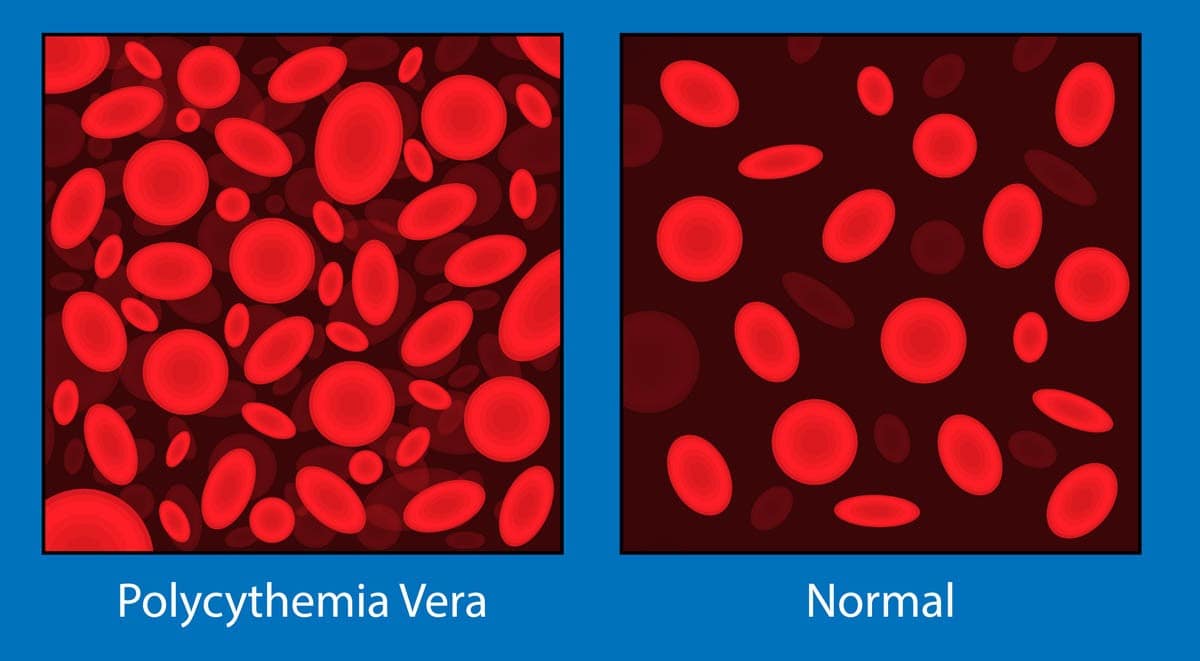At a glance
|
What is polycythemia?
Also known as erythrocythemia, polycythemia (PV) is a rare blood disorder in which there is an abnormal number of red blood cells in the blood.
The blood is composed of plasma which is the clear fluid component of blood containing antibodies, electrolytes and other proteins, red blood cells, white blood cells and platelets. Red blood cells are the most common type of cell in the blood, amounting to 35-45% of whole blood. Polycythemia is defined as a red blood cell count above 55%. Brachycephalic breeds such as Persians and Exotics, as well as cats who live at higher altitudes, may have a higher packed cell volume than other cats.
There are three classifications of polycythemia in cats:
Relative polycythemia
The most common cause of polycythemia is most commonly due to dehydration. Red blood cell counts are normal, however, plasma levels are reduced which causes an elevated packed cell volume (PCV). This test measures the volume of red blood cells compared to the fluid portion of the blood.
Transient polycythemia
The spleen is an organ that in part is responsible for storing red blood cells, if the spleen contracts as a result of epinephrine secretion, it will release a large number of red blood cells into the bloodstream.
Absolute polycythemia
Also known as true polycythemia, absolute polycythemia results in an overproduction of red blood cells. It may be primary (polycythemia rubra vera) or secondary.
- Primary polycythemia is due to the overproduction of red blood cells in the bone marrow, which is known as myeloproliferative neoplasms).
- Secondary may be due to erythropoietin secreting tumours or inappropriate administration of erythropoietin (when treating anemia caused by kidney disease). Erythropoietin (EPO) is a hormone produced by the kidney which promotes the formation of red blood cells). Other causes of secondary polycythemia may include heart disease and lung disease which cause hypoxia (low levels of oxygen in the blood), which triggers an increase in EPO production.
The average age in cats with polycythemia is 8-9 years old and short-nosed breeds will often have a higher packed cell volume than other cats due to decreased oxygen intake.
Symptoms
When all blood components are at normal levels, blood is able to flow freely blood vessels throughout the body. However, if red blood cell levels are higher than normal, the blood becomes thicker (known as hyperviscosity), making it more difficult to travel through the smaller blood vessels. This results in reduced oxygen levels reaching the tissues. Symptoms can vary depending on the underlying cause and the type of polycythemia.
Cats with polycythemia vera may not display symptoms until a high degree of hyperviscosity has developed.
One of the most common symptoms of polycythemia is the development of neurological disorders such as seizures, ataxia (unsteady gait), behavioural changes and blindness
Other symptoms may include:
- Hyperemic mucus membranes (dark/red brick colouration to the gums)
- Reddening of the skin
- Lethargy
- Weakness
- Loss of appetite
- Nosebleeds
- Increased thirst and urination
- Dark, tarry feces
- Blood in the urine
- The spleen removes damaged or abnormal cells from the blood and has to work harder when the cat has polycythemia, over time can enlarge (splenomegaly) as a result.
Relative polycythemia is most often due to dehydration which may be associated with prolonged vomiting, diarrhea, increased urination and sickness in which may have resulted in your cat taking in fewer fluids or lack of available drinking water.
Cats with secondary polycythemia due to kidney tumours, heart or lung disease may display additional symptoms related to these diseases.
Diagnosis
You and your veterinarian may not be aware your cat has polycythemia until it is found during a routine complete blood count where the packed cell volume is greater than 55%.
Your veterinarian will perform a complete physical examination of your cat and obtain a medical history from you including medical history and any medications the cat is taking.
It will be necessary to determine what type of polycythemia your cat has, relative, transient or absolute.
Routine urinalysis will pick up relative polycythemia.
Absolute polycythemia will require additional testing which may include:
- Serum EPO level
- Arterial blood gas levels
- Abdominal ultrasound, x-ray or contrast radiography to evaluate the kidneys for signs of kidney disease or tumours as well as evaluate the spleen for signs of enlargement
- Thoracic x-rays or ultrasound to look for causes of hypoxic disease such as heart or lung disease
- Bone marrow biopsy
Treatment
Treatment depends on the type of polycythemia your cat has.
Relative polycythemia
- Fluid therapy to correct dehydration will be given via intravenous injection.
Absolute polycythemia
- Surgery to remove tumours.
- Manage heart or lung disease with medications which include beta-blockers and diuretics.
- Therapeutic phlebotomy (fle-bot-omy) involves the removal of between 10-20 mL per kg of your cat’s blood, this helps to decrease blood viscosity by removing excess red blood cells.
- One cat was treated with leech therapy as hyperviscosity made it impossible to perform phlebotomy, although this is an isolated case.
- Iron supplements may be necessary for some cats who may develop low iron levels due to phlebotomy.
- Hydroxyurea (Hydrea) is an antimetabolite drug that can be prescribed to cats who cannot be treated and where phlebotomy is not enough to control blood cell counts. This medication slows down the production of red blood cells in the bone marrow. Side effects may include thrombocytopenia (decreased platelet count), leukopenia (decreased white blood cell count) due to myelosuppression, anemia, vomiting, diarrhea, and loss of appetite.
Many cats will require lifelong monitoring of PCV and phlebotomies every 6-8 weeks. It will be possible to wean some cats off hydroxyurea but others will need to stay on the drug for life.
Only administer medications prescribed by your veterinarian.
The prognosis for cats with absolute polycythemia is poor, although some cats have lived for several years after diagnosis.

